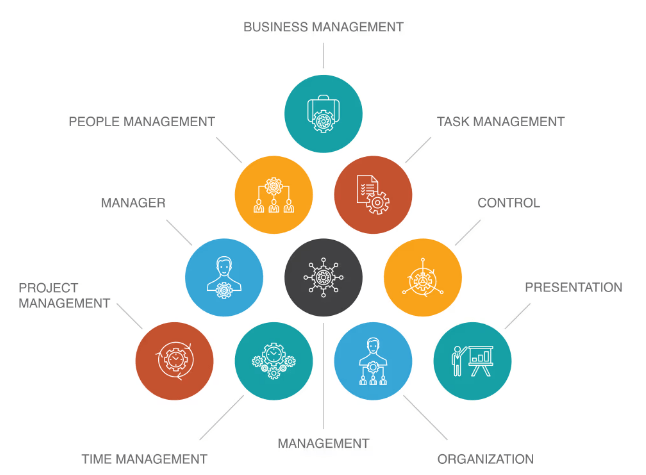
- Introduction
- Definition of Management
- Definition of Administration
- Key Differences Between Management and Administration
- Scope of Work
- Level of Authority
- Roles and Responsibilities
- Conclusion
Introduction
In any organization, effective coordination of activities and processes is essential to ensure smooth operations and long-term success. Two of the most crucial elements in this coordination are management and administration. Though often used interchangeably, these two functions have distinct meanings, roles, and responsibilities. Understanding the differences between management and administration is vital for leaders, employees, and stakeholders who aim to contribute meaningfully to an organization’s goals. Management refers to the process of planning, organizing, leading, and controlling resources to achieve specific objectives efficiently and effectively. Managers focus on implementing policies, directing staff, and making operational decisions that influence the daily functioning of the organization. Their role is action-oriented, dealing with people and processes to ensure productivity and performance monitoring. On the other hand, administration is concerned with setting the organization’s overall goals, policies, and frameworks. Administrators are typically involved in decision-making at the highest level, including defining objectives, formulating strategies, and allocating resources. Their work is more strategic and policy-focused, providing the foundation upon which management operates. Both management and administration play vital roles in an organization. Administration provides the vision and strategic direction, while management ensures that the day-to-day activities align with these broader goals. Together, they create a system where long-term planning and short-term execution work hand in hand. This synergy is essential for maintaining order, achieving efficiency, and adapting to changes in the business environment. In the sections that follow, we will explore their individual characteristics and how they interact within different organizational settings.
Definition of Management
Management refers to the process of planning, organizing, leading, and controlling the resources of an organization to achieve its goals effectively and efficiently. It involves coordinating people, finances, information, and materials to implement business strategies and ensure smooth operations. Management is action-oriented, focusing on meeting specific objectives within a set timeframe while making the best use of available resources. The primary aim of management is to help the organization reach its goals by optimizing resource utilization. Managers are responsible for overseeing day-to-day activities and ensuring that all tasks align with the company’s vision and strategic objectives. They lead teams, solve operational problems, allocate resources appropriately, and evaluate the performance of both employees and processes to maintain productivity and quality. Management consists of several core functions. The first is planning, which involves setting clear goals and deciding the best course of action to achieve them. Planning serves as a roadmap that guides the organization’s efforts. Next is organizing, where managers arrange resources and tasks systematically to execute the plan efficiently. This includes defining roles, assigning responsibilities, and establishing workflows. The third function is leading, which focuses on motivating, directing, and guiding employees to work toward the organization’s objectives.

Effective leadership helps build team cohesion and drives employee performance. Lastly, controlling involves monitoring ongoing activities, measuring actual performance against planned goals, and implementing corrective actions if there are deviations. Together, these functions enable managers to maintain control over the organization’s operations and steer it toward success.
Definition of Administration
- Basic Definition: Administration refers to the process of planning, organizing, directing, and controlling resources to achieve specific organizational goals efficiently and effectively.
- Management Function: It is a fundamental function of management that ensures all organizational settings activities are coordinated and resources are optimally utilized to meet objectives.
- Decision-Making: Administration involves making key decisions related to policies, procedures, and day-to-day operations to guide the organization toward its mission.
- Resource Coordination: It includes managing human, financial, physical, and informational resources, ensuring they work harmoniously to produce desired outcomes.
- Organizational Structure: Administration defines the organizational structure by establishing roles, responsibilities, and communication channels to streamline workflow.
- Goal Achievement: The ultimate purpose of administration is to facilitate the achievement of organizational goals by implementing plans and monitoring progress regularly.
- Scope and Application: Administration applies to all types of organizations, businesses, governments, educational institutions, and non-profits playing a crucial role in maintaining order and promoting growth.
- Definition: Management focuses on executing organizational settings plans by coordinating resources and activities to achieve specific goals. Administration, on the other hand, involves setting overall policies, objectives, and the strategic direction of the organization.
- Scope of Work: Administration has a broader scope, covering policy formulation and long-term decision-making at the top level. Management’s scope is narrower, concentrating on implementing these policies within departments or teams.
- Level of Authority: Administration is typically performed by top-level executives like CEOs and board members who hold the highest authority. Management is carried out by middle and lower-level managers responsible for day-to-day operations.
- Nature of Activities: Administration is strategic and conceptual, involving planning and policymaking. Management is more operational and tactical, focusing on organizing, directing, and controlling resources to meet objectives.
- Decision-Making: Administrative decisions are broad and long-term, affecting the entire organization. Management decisions tend to be specific, short-term, and related to daily activities and problem-solving.
- Focus Areas: Administration emphasizes establishing goals, framing policies, and overall governance. Management focuses on implementing those policies, managing teams, and achieving departmental or project goals.
- Required Skills: Administration demands strong conceptual and analytical abilities to envision and guide the organization’s future. Management requires technical expertise, interpersonal, and leadership skills to supervise and motivate employees effectively.
- Management operates at various levels: Managers work at different tiers within an organization, including top-level executives, middle managers, and front-line supervisors, each with specific responsibilities and authority.
- Operational authority of management: Managers have the power to make decisions related to daily operations. Their main role is to implement policies and procedures laid out by the administration and ensure smooth functioning within their areas.
- Focus on execution: Management’s authority revolves around executing plans, coordinating resources, overseeing employee performance, and ensuring that departmental goals align with the organization’s objectives.
- Administration holds the highest authority: Administrators such as CEOs, board members, and senior executives occupy the topmost positions in the hierarchy, wielding ultimate decision-making power.
- Strategic decision-making: Administration is responsible for setting the organization’s policies, vision, mission, and long-term goals. They make decisions that affect the company’s overall direction and sustainability.
- Control over major organizational resources: Administrators approve large-scale project goals, allocate budgets, and establish priorities that influence the company’s growth and market positioning.
- Difference in focus and impact: Management’s authority is primarily operational and short-term, focusing on day-to-day efficiency. In contrast, an administration’s authority is strategic and long-term, guiding the organization’s future and overall success.
Key Differences Between Management and Administration

Scope of Work
The scope of work for management and administration differs significantly, reflecting their distinct roles within an organization. Management primarily focuses on operational activities, while administration deals with overall governance and strategic direction. The scope of management involves supervising the performance of staff and departments to ensure that organizational goals are met effectively. Managers implement policies and procedures developed by the administration, ensuring that they are followed consistently across all levels. They are responsible for managing financial resources within their departments, overseeing budgets, and making day-to-day decisions related to operations. Handling routine tasks, solving problems as they arise, and coordinating workflows are key management functions that keep the organization running smoothly on a daily basis. In contrast, the scope of administration is broader and more strategic. Administrators establish the organization’s vision, mission, and long-term goals, providing a clear direction for future growth. They formulate policies that guide the entire organization, setting standards and frameworks that managers then execute. Resource allocation at a macro level is another important administrative function, ensuring that the organization’s assets are distributed according to strategic priorities. Administration is responsible for setting the overall course and making high-level decisions that impact the organization’s sustainability and success. While management operates at all levels of the organization from frontline supervisors to middle and upper management, administration generally functions at the executive or leadership skills level. Together, both management and administration complement each other by balancing strategic planning with effective operational execution, which is essential for an organization’s overall performance.
Level of Authority
Roles and Responsibilities
Management plays a vital role in the success of any organization by ensuring that resources and efforts are directed towards achieving business objectives. One of the key responsibilities of management is team leadership. Managers are tasked with overseeing teams, departments, and individual employees, guiding them to work cohesively and efficiently. Effective leadership skills motivates employees, fosters collaboration, and aligns their efforts with the organization’s goals. Another important role is resource allocation. Managers must ensure that all resources, including human capital, materials, and financial assets, are used optimally. Efficient allocation helps reduce waste and maximizes productivity, which contributes to the overall success of the organization. Managers evaluate available resources and distribute them based on priority and need to support various project goals and operations. Managers are also responsible for the execution of policies created by the administration. They translate high-level strategies into actionable plans and make sure that organizational policies are followed at every level. This ensures consistency and helps maintain order within the business. Problem-solving is a continuous responsibility for managers. They address daily challenges, resolve conflicts, and remove obstacles that could hinder performance. By quickly and effectively handling issues, managers keep operations running smoothly. Finally, performance monitoring is crucial. Managers regularly measure the progress of individuals and teams against set objectives. They analyze results, provide feedback, and make necessary adjustments to ensure that targets are met efficiently. Together, these roles and responsibilities highlight the proactive and hands-on nature of management in driving organizational success.
Conclusion
In conclusion, management and administration are two essential functions that together form the backbone of any successful organization. Although they are closely related, their roles and responsibilities differ in important ways. Management primarily focuses on the day-to-day operations, ensuring that tasks are completed efficiently and that resources are used effectively. Managers lead teams, solve problems, implement policies, and performance monitoring to meet the organization’s immediate goals. Their role is practical and action-oriented, dealing directly with the workforce and operational processes. On the other hand, administration is more strategic and policy-driven. Administrators establish the organization’s vision, mission, and long-term objectives. They develop the policies and frameworks that guide management’s activities and make high-level decisions about resource allocation and organizational direction. Administration provides the necessary structure and guidance within which management functions. Both management and administration are interdependent and must work in harmony to drive the organization forward. Without effective administration, management would lack clear direction, while without strong management, the strategies and policies set by administration would not be implemented successfully. Understanding the differences between these functions and how they complement each other is crucial for leaders and employees alike. By clearly defining their distinct roles and fostering collaboration between management and administration, organizations can achieve smoother operations, improved decision-making, and sustainable growth. Ultimately, the combined efforts of management and administration create a balanced environment that supports both the immediate needs and the long-term vision of the organization, ensuring its continued success and adaptability in a changing business landscape.





